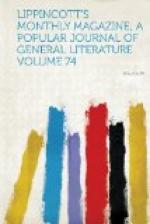One cannot find in all America sweeter and quainter memorials of a gentle past—memorials still consecrated to the gracious work of the present—than the churches and other denominational houses in the old Moravian towns of Pennsylvania. At Bethlehem, as one stands in the little three-sided court on Church street and looks up at the heavy walls, the tiny dormer windows and the odd-shaped belfry which mark the “Single Sisters’ House” and its wings, one may well fancy one’s self, as a travelled visitor has said, in Quebec or Upper Austria. Still more quaint and quiet is Willow Square, behind this curious house, where, beneath drooping willow-boughs, one finds one’s self beside the door of the old German chapel, with the little dead-house, the boys’ school and the great and comparatively modern Moravian church near by. Through Willow Square leads the path to the burying-ground, where lie, beneath tall trees, long rows of neatly-kept graves, each covered with a plain flat stone, the men and the women lying on either side of the broad central path. Several of the ancient Moravian buildings date from the middle of the last century. The Widows’ House stands, opposite the Single Sisters’ Range, and across the street from the large church is the Moravian Seminary for Young Ladies, established in 1749, and by far the oldest girls’ school in the United States.
It was in 1778 that the Single Sisters gave to Pulaski that banner of crimson, silk which is commemorated in Longfellow’s well-known “Hymn of the Moravian Nuns at Bethlehem.” The poem, however, written in the author’s early youth, and preserved for its rare beauty of language and fine choice of subject, rather than for its historical accuracy, has done much to perpetuate a wrong idea of the Moravian spirit and ritual. Mr. Longfellow writes in his first stanza
When the dying
flame of day
Through the chancel
shot its ray,
Far the glimmering
tapers shed
Faint light on
the cowled head,
And the censer
burning swung,
When before the
altar hung
That proud banner,
which, with care,
Had been consecrated
there;
And the nuns’ sweet hymn was heard
the while,
Sung low in the dim, mysterious aisle.
But the Moravians know nothing of chancels, tapers, cowled heads, censers, altars or nuns. Their faith has always been the simplest Protestantism, their churches are precisely such as Methodists or Baptists use, and their ritual is plainer than that of the most “evangelical” Episcopal parish. Their “single sisters’ houses,” “widows’ houses” and “single brethren’s houses”—the last long disused—are simply arrangements for social convenience or co-operative housekeeping. Mr. Longfellow’s poetic description applies to the Moravian ceremonial no more accurately than to a Congregational prayer-meeting or a Methodist “love-feast.”
[Illustration: THE MORAVIAN CEMETERY, BETHLEHEM, PENNSYLVANIA.]




